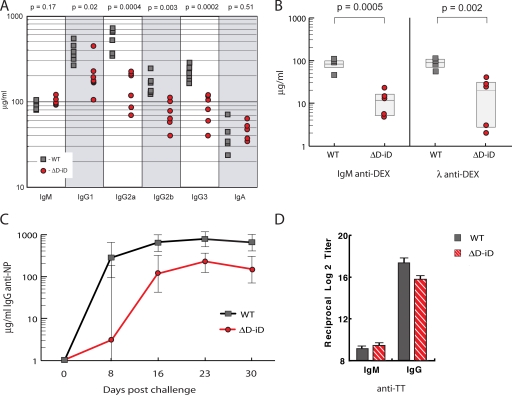Figure 6.
Alterations in humoral immune function in homozygous ΔD-iD mice. (A) The concentrations of IgM, IgG1, IgG2a, IgG2b, IgG3, and IgA in the serum of six 8-wk-old homozygous ΔD-iD and six homozygous WT littermates (ELISA). The geometric mean concentration of IgM (104 μg/ml [91–118, 95% confidence limits] and IgA (47 μg/ml [34–63]) proved comparable to WT (94 μg/ml [80–109], P = 0.17; and 38 μg/ml [23–64], P = 0.51, respectively). In contrast, the geometric mean concentrations of all four IgG subclasses were significantly reduced in the mutant mice. (IgG1 201 μg/ml [122–329] vs. 382 μg/ml [267–543]; P = 0.02; IgG2a 141 μg/ml [81–245] vs. 516 μg/ml [333–799]; P = 0.0004; IgG2b 71 μg/ml [48–106] vs. 155 μg/ml [108–224], P = 0.003; and IgG3 82 μg/ml [52–130] vs. 224 μg/ml [171–293]; P = 0.0002, respectively). (B) The primary T-independent response to α-1,3 dextran (DEX) is diminished in homozygous ΔD-iD mice. The geometric mean concentrations of anti-DEX IgM and Igλ antibody titers 7 d after immunization were 10 μg/ml [4–23] vs. 79 μg/ml [43–143], and 11 μg/ml [2–63] vs. 83 μg/ml [51–134], respectively; P < 0.01). Titers in preimmune sera were <1 μg/ml; not depicted. (C) The primary T-dependent IgG response to NP19-CGG in homozygous. ΔD-iD mice is diminished when compared with WT littermates. **, P < 0.01; ***, P < 0.001. (D) TT-specific antibody responses in ΔD-iD mice. 24 homozygous ΔD-iD and 24 WT littermate controls were each orally immunized with 250 μl of 5 × 109 rSalmonella-ToxC. 4 wk later, plasma samples were collected and subjected to TT-specific ELISA. The data are shown as the reciprocal log2 titer. For ΔD-iD the mean IgM and IgG anti-TT titers were 9.1 ± 0.2 and 15.1 ± 0.5, respectively; whereas, for WT IgG the mean titer were 9.3.1 ± 0.2 and 17.5 ± 0.3 (P = 0.64 and P = 0.0004, respectively).

